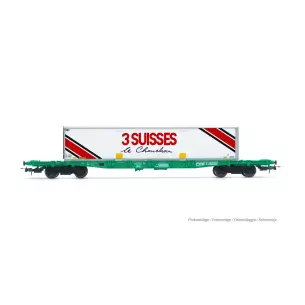Êtes-vous sûr de vouloir effectuer cette action ?


JURA MODÉLISME
Need a freight train? Jura modélisme has a large catalogue of train wagons that faithfully reproduce the rolling stock of major public and private railway companies (SNCF, ÖBB, MOB, CFF, etc.). New models are added to the database every week. Our index has been designed to help you run model trains in analogue or digital.
Our model products are classified by car type. The categories opposite give you a quick overview of our range. Click on the thumbnails to see train wagons made by Hornby, Piko, Roco, Märklin and Minitrains. These manufacturers are renowned for the quality of their reproductions.
To get you started, we have created filters that allow you to sort train carriages by brand, brand name, railway company and scale. You will of course find miniatures in the HO scale, but also in the N, Z or G scales. If you're a collector, you'll also find replicas of old trains from Class I or Class II. Our catalogue is perfect for putting together a freight train that recounts a great page from the history of the railways.
The term wagon comes from the Dutch word wagen, meaning carriage or car. In French, its meaning is slightly different. In the world of railways, a train carriage is used solely for the transport of goods. The car, on the other hand, is reserved for passenger transport. As the cheminots do, we should therefore say distinguish thepassenger car from the freight car.
Awagon is anon-motorised railway vehicle - also known as atrailer. It carries freight and moves thanks to the pulling force of an engine. Goods trains therefore consist of a locomotive and trailers. The shape of these trailers changes according to their cargo:
The shape of these trailers changes according to their cargo: The shape of these trailers changes according to their cargo.- flat wagons - container wagons - the trémie - wagons à sliding walls - tank wagons To attach wagons,a coupler system is essential. According to the scale used, the screw coupling is the most widely used system in Europe. It connects two train carriages by means of a draw hook and a movable shackle. In terms of rail systems, it's a different story. There are coupling systems that do not exist in real life. For a long time, the different makes of model railway each developed their own coupling system, which posed major problems of compatibility. From the 1950s onwards, European design standards (NEM) made it possible to unify things a little, forcing manufacturers to comply with certain standards. A universal box has been developed, but it is universal in name only. In fact, a multitude of hitches can be clipped onto it. Before buying a train carriage, it's important to check that the coupling system is compatible with that of your rolling stock, and that it matches what you want to do. Here's the most popular coupling: the standardised buckle NEM 362. Is this your firstelectric train ? A starter kit is an interesting solution for acquiring railcars. In fact, this formula has several advantages:
These open wagons are formed of a châssis mounted onaxles and stakes, vertical bars that hold the load. They are used to transport heavy or bulky materials that cannot withstand bad weather.
This rolling stock is a link in the intermodal transport chain. Intermodal transport combines several means of locomotion to transport freight (train, truck, ship). On the rails, it is mainly used to transport swap bodies, containers and semi-trailers.
This wagon is shaped like a large funnel mounted on wheels. It carries bulk materials such as ballast, waste, salt and sand. At SNCF, these vehicles are fitted with Y 25 type bogies used for heavy wagons.The cargo is loaded from the top, then emptied through a hatch at the base of the wagon.
This box wagon carries goods that are sensitive to climatic aléas. Its sliding side doors cover the entire width of the compartment. Once open, the wide opening allows cargo to be loaded and unloaded quickly. That's a big advantage for a rail freight company.
This train wagon is designed to transport liquids. There are partitioned, refrigerated or heat-insulated tanks. These rail convoys transport milk, oil, wine and liquefied gas.
Which coupling to choose ?
When to opt for a box de départ ?
1- Price. Many of the starter sets offered by Jura modélisme contain wagons. There are various types of towed equipment. The price of these items is generally lower in these special offers than the unit price.
2- Compatibility. As well as the carriages, these complete kits also contain a control box (analogue or digital), a locomotive and the brass track. In short, everything you need to run a model train. When you start out in model railroading, a starter kit allows you to get off to the right start by avoiding compatibility problems, particularly with the coupling system, as we saw earlier.
To find out more, don't hesitate to check out our range of part kits.
In résumé
A wagon is a railway vehicle used exclusively fortransporting goods. It is therefore sometimes incorrectly referred to as a passenger wagon. In the world of toys, as in reality, there is a wide variety of railcars. To put together a train frame, it is important to consider certain information such as the scale, the hull, or the coupling system of the rolling stock. If you're new to model railroading, a starter set is a great way to acquire wagons, a locomotive, a control system and rails to lay the foundations for a model railroad project.
Êtes-vous sûr de vouloir effectuer cette action ?